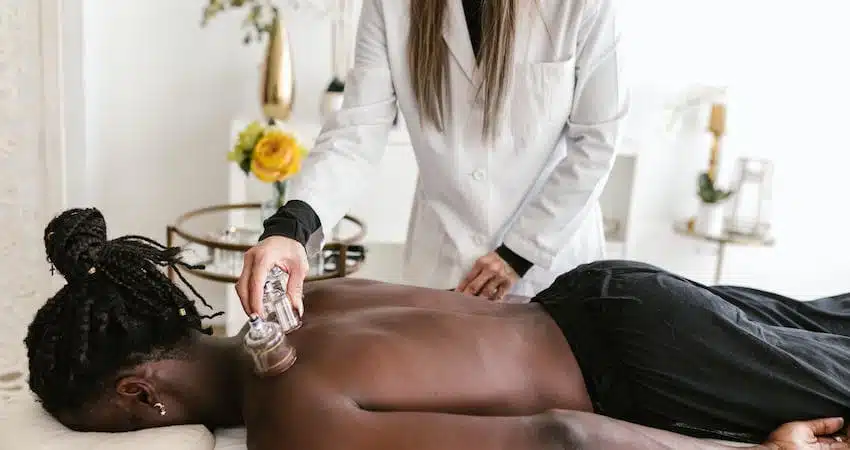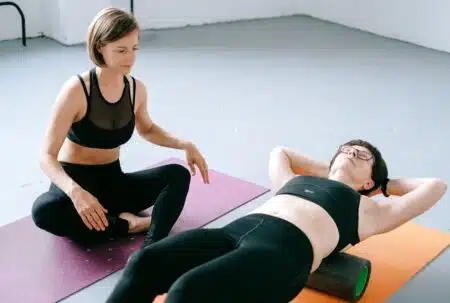Have you ever caught sight of those eye-catching circular bruises on celebrities or Olympic athletes and wondered “What on earth is that?” Those distinctive marks originate from an ancient healing practice rapidly gaining popularity – cupping therapy. But what is cupping? How does it work? And does it really deliver scientifically-backed benefits, or is it just pseudoscience hype? This guide demystifies this practice, exploring its origins, methods, proposed effects, modern uses and evidence behind the claimed advantages. Time to unravel fact from fiction!
What is Cupping?
You’ve likely seen those telltale cupping circles before, whether on Hollywood A-listers, premier athletes or your neighborhood massage therapist. These markings signify the use of cupping – an ancient therapeutic technique using suction to potentially stimulate healing. While it has existed for thousands of years across various cultures, it remains shrouded in mystique for the average individual. This unique modality requires deeper understanding. What truly happens during a cupping session, and how might it benefit those seeking next-level wellness?
Tracing Cupping's Roots and Evolution
The core principles behind cupping originated in traditional Chinese and Middle Eastern medicine, where experts developed specialized tools and techniques to gently draw skin into suction cups made of bamboo, clay, glass or animal horns. Remarkably, numerous ancient cultures from Egypt to Greece independently pioneered similar practices long predating modern times.
The core concept involves placing inverted cups on the skin, utilizing heat or suction pumps to create a partial vacuum. This vacuum gently lifts and pulls the skin upward several centimeters into each cup. The underlying belief maintains that this suction boosts circulation, drains areas of stagnant blood and fluids, eases pain and restores metabolic balance.
Despite enduring misconceptions, cupping isn’t meant to simply produce distinctive circular bruises. Rather, the aim is to indirectly stimulate soft tissues and modulate physiological processes through suction’s specialized impact on targeted areas.
Exploring Cupping Techniques and Tools
Today’s cupping specialists leverage a variety of techniques and equipment evolved over centuries to customize therapy for each patient’s unique needs and goals. Common approaches include:
- Dry Cupping – The most fundamental method placing cups directly on clean, lubricated skin to create suction without any additional interventions.
- Wet Cupping – A more advanced technique making minor dermal incisions with a surgical knife before applying cups. The suction draws out and removes a small quantity of stagnant blood from the treatment area.
- Flash Cupping – Rapidly lifting and reapplying cups across multiple areas in the span of minutes creates a pumping action to circulate blood flow.
- Moving/Massage Cupping – Applying lubricating oils or creams to facilitate the gliding of cups slowly across muscles akin to massage strokes for deeper tissue release.
Practitioners of this technique rely on an array of specialized cups fabricated from materials like plastic, silicone, rubber or treated bamboo to optimize therapy. Cup shapes, designs and degrees of suction vary widely. Electrically-powered suction pumps offer increased precision and safety over traditional heat-suction methods as well. Overall, this practice encompasses a range of customizable techniques and approaches holistically targeting mind and body.
Investigating Claimed Cupping Benefits
Proponents of cupping therapy point to various purported therapeutic benefits aligning with its millennia of traditional use. However, sorting out folklore from evidence-based effects remains challenging. Some of the most commonly cited potential advantages include:
- Pain Relief – Multiple studies indicate that it triggers release of natural pain-relieving chemicals, modulating pain pathways similarly to acupuncture to reduce discomfort. Enhanced circulation to tense muscle areas may also accelerate healing and detoxification.
- Immune Function Boost – By improving circulation, it may aid the elimination of metabolic wastes and facilitate immune cell circulation to nurture the body’s self-repair capabilities. Preliminary research observed positive immune impacts in patients undergoing some cancer treatments.
- Relaxation/Stress Relief – Partially related to any pain-relieving impacts, it may help relieve anxiety and sadness by elevating mood-boosting hormones like oxytocin and serotonin. However, the jury remains out on how it compares to conventional massage and stress relief practices.
- Targeting Optimal Treatment Areas – Where should professionals apply those eye-catching cupping circles to elicit the best therapeutic benefits? Typical target areas include:
- Back and Shoulders – Relieving pain and tension from injuries, strain, poor posture, nerve issues like sciatica and muscle spasms.
- Neck – Tackling neck stiffness, stress-related tension and resulting headaches or migraines.
- Abdomen – Stimulating sluggish circulation and peristalsis to combat digestive issues like bloating and pelvic discomfort.
- Hips and Legs – Facilitating healing and comfort with chronic conditions like sciatica, arthritis and muscle strains.
The duration of cupping sessions may vary substantially from 5-20 minutes depending on patient comfort levels and the practitioner’s intended impact on blood flow. It’s normal for treated areas to retain distinctive reddish circular marks resembling bruises for 5-7 days following therapy as the area heals.
Evaluating Modern Evidence and Ambiguities
While traditional cupping practices boast thousands of years of continuous use across diverse regions and cultures, rigorous modern research evaluating its efficacy remains quite limited compared to other therapies. The relatively few high-quality clinical trials tend to focus specifically on its potential as a pain relief modality.
According to a comprehensive systematic review of available studies published in 2021, cupping therapy alone or in combination with medications produced significant pain improvements compared to no treatment or “sham” placebo controls for conditions like cancer pain, low back pain and osteoarthritis. Some studies even showed it matched or modestly outperformed prescription medications like morphine or ibuprofen.
However, researchers caution that larger, higher-quality clinical trials on a wider breadth of medical conditions are still sorely needed before definitive assessments can be made. Pain relief benefits may be partially or entirely attributable to placebo effects or heightened circulation delivering more oxygen to sore areas. Consulting doctors and licensed professionals before cupping is highly advisable.
Maximizing Potential Healing, Minimizing Risks
Cupping is widely viewed as relatively low-risk when administered by well-trained and properly credentialed practitioners following sterilization best practices. The most frequently encountered negative side effects are usually minor – temporary muscle soreness, slight rash or skin irritation in treated areas, or hives or skin redness persisting several days.
However, improperly sterilizing cups heightens risks of transmissible infections. Wet cupping techniques also pose potential dangers of excessive blood loss or hitting veins in rare instances for those with pre-existing bleeding disorders. Individuals with blood clotting issues, diagnosed deep vein thrombosis, tumors or implanted medical devices should avoid cupping and seek doctor approval first.
Optimal results come when licensed cupping therapists customize techniques precisely to the individual’s physiology, medical history and situational needs. With appropriate precautions and guidance from trained professionals, this centuries-old therapy offers intriguing potential complementing modern medicine to enhance wellbeing.
Navigating Optimum Paths to Holistic Healing
At the end of the day, no single healing modality represents a cure-all. However, integrative approaches like cupping offer patients powerful tools when utilized alongside healthy lifestyle changes, medical care and other therapies.
The proven benefits of circulating stagnant fluids, enhancing blood flow and gently releasing tension in targeted areas provide a compelling rationale for cupping therapy – particularly for acute or chronic pain conditions. However, it’s vital to investigate practitioners thoroughly, research best practices for your unique health situation, and approach it as one facet of an overall wellness plan.
In the right hands, cupping can be an adjunct to recovery, but is not a sole solution. With reasonable expectations aligned to the evidence and a holistic healing mindset, the careful application of this time-tested therapy yields intriguing potential for modern patients seeking enhanced quality of life.



